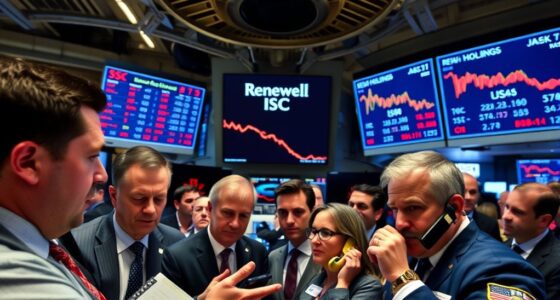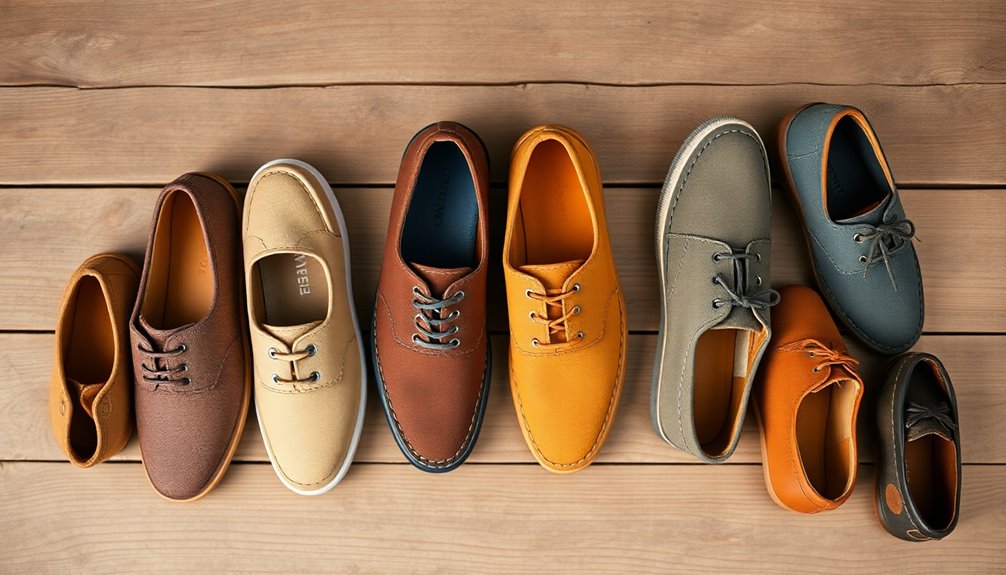Balancing profit and principles in luxury and fashion means embracing sustainable practices, transparency, and innovation while maintaining exclusivity. You can support brands that utilize eco-friendly materials, responsible sourcing, and circular economy initiatives. Transparency tools like blockchain help verify ethical claims, showing your commitment to responsible luxury. If you want to understand how heritage, technology, and sustainability can work together, explore the key strategies shaping eco-luxury today.
Key Takeaways
- Integrating sustainable materials and transparent supply chains enhances brand reputation while aligning with ethical principles.
- Balancing exclusivity with eco-friendly innovations addresses consumer demand for responsible luxury.
- Investing in eco-technologies and circular economy practices reduces environmental impact without compromising quality.
- Clear communication of ethical sourcing and environmental efforts builds consumer trust and brand loyalty.
- Addressing resource-intensive processes and material scarcity challenges requires innovation and commitment to sustainability goals.
The Environmental Footprint of Luxury and Fashion

The fashion industry, including luxury brands, considerably impacts the environment by contributing around 10% of global carbon emissions and producing 20% of textile wastewater. This environmental impact stems from manufacturing, resource extraction, and waste, which profoundly increase your carbon footprint. As an eco-conscious consumer, you can advocate for responsible practices by supporting brands that prioritize waste reduction and sustainable methods. Many luxury companies are beginning to adopt sustainable practices, such as using eco-friendly materials and reducing packaging waste. Recognizing the environmental costs of fast fashion and excessive packaging encourages you to choose brands committed to responsible practices. By making informed choices, you contribute to lowering the industry’s waste and pollution, fostering a more sustainable future for luxury and fashion. Additionally, understanding the core personality traits of industry leaders can help consumers better identify brands that align with their values. Incorporating sound design principles in communication strategies can also enhance awareness campaigns about sustainability efforts. Moreover, awareness of regulatory policies related to environmental standards can motivate brands to improve their sustainability initiatives. Emphasizing sustainable manufacturing techniques further supports eco-friendly innovation within the industry.
Embracing Sustainable and Eco-Luxury Practices
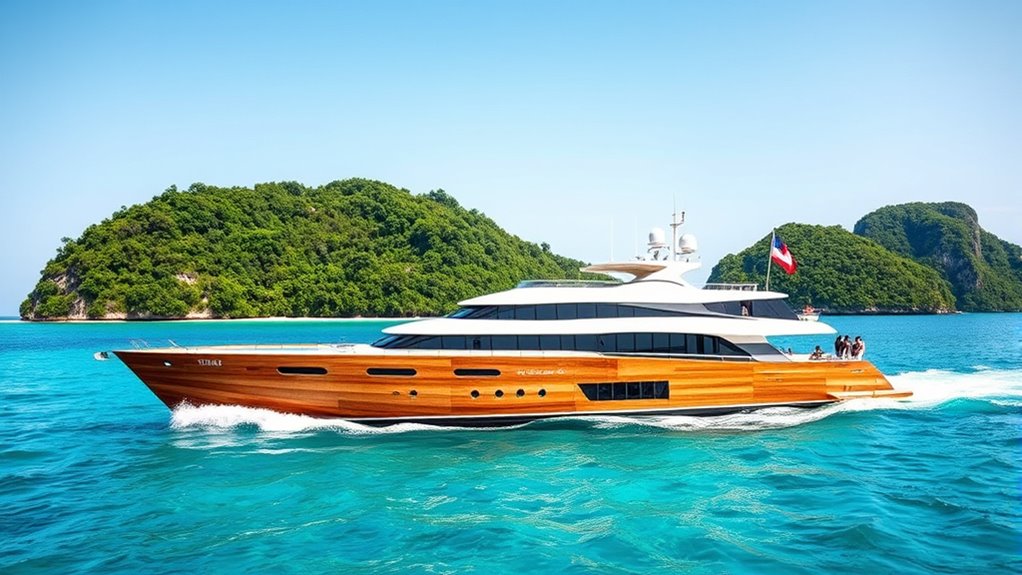
You can see how innovation in eco-friendly materials is transforming luxury, with brands like Stella McCartney leading the way using animal-free fabrics. Transparency in supply chains is becoming essential, as companies adopt tools like environmental profit reports to build trust. By embracing these practices, you help push the industry toward more responsible and sustainable luxury choices. Eco-friendly materials are increasingly being integrated into high-end products, demonstrating that luxury and sustainability can go hand in hand. Additionally, consumer demand for ethical sourcing encourages brands to prioritize transparency and responsible practices throughout their production processes. Recognizing the importance of sustainable practices, many companies are now focusing on reducing their environmental impact and supporting fair labor standards. Incorporating mindfulness and emotional intelligence into business practices can further enhance ethical decision-making and stakeholder trust.
Eco-Friendly Materials Innovation
Innovations like Mylo mushroom leather and bio-plastics are transforming how luxury brands approach sustainability, offering eco-friendly alternatives that don’t compromise on quality or style. These sustainable materials exemplify eco-friendly innovations that elevate luxury products while aligning with ethical practices. By integrating eco-materials, luxury brands reduce environmental impact and promote circular economy principles. This shift not only enhances brand prestige but also responds to consumers’ demand for responsible consumption. Developing these materials involves cutting-edge research and collaborations with startups, which helps lower resource consumption and streamline the supply chain. As a result, eco-friendly innovations in luxury fashion are setting new standards, proving that sustainability and luxury can coexist without sacrificing elegance or excellence. Incorporating natural materials such as wood, stone, and linen further emphasizes the commitment to authentic and sustainable design practices. Additionally, adopting lightweight and durable woods like Baltic birch and poplar in various applications exemplifies how material choices can support both sustainability and high-quality craftsmanship.
Transparent Supply Chains
Transparent supply chains are transforming how luxury brands demonstrate their commitment to sustainability and ethics. By prioritizing transparency, you can verify the origin of materials, ensuring ethical sourcing and enhancing traceability. Digital tools like blockchain, used by brands such as Gucci and Gabriella Hearst, allow real-time tracking of products, building consumer trust. These initiatives help identify and eliminate unethical practices, like child labor or unsafe conditions, within sourcing processes. Transparency also highlights sustainable practices, like using recycled materials or bio-plastics, appealing to eco-conscious buyers. Imagine this:
| Material Origin | Ethical Practice | Sustainability Impact |
|---|---|---|
| Recycled Plastic | Fair Labor Standards | Reduced Carbon Footprint |
| Organic Cotton | No Child Labor | Eco-Friendly Production |
| Bio-Based Materials | Safe Working Conditions | Lower Environmental Impact |
This clarity in supply chains strengthens your brand’s reputation and promotes genuine eco-luxury. A focus on sustainable practices further underscores the importance of ethical sourcing and environmental responsibility. Incorporating traceability technology into your supply chain allows for even greater transparency and accountability, especially in sectors like the Private Placement Equity Markets, where due diligence is essential.
Heritage, Innovation, and the Future of Responsible Luxury
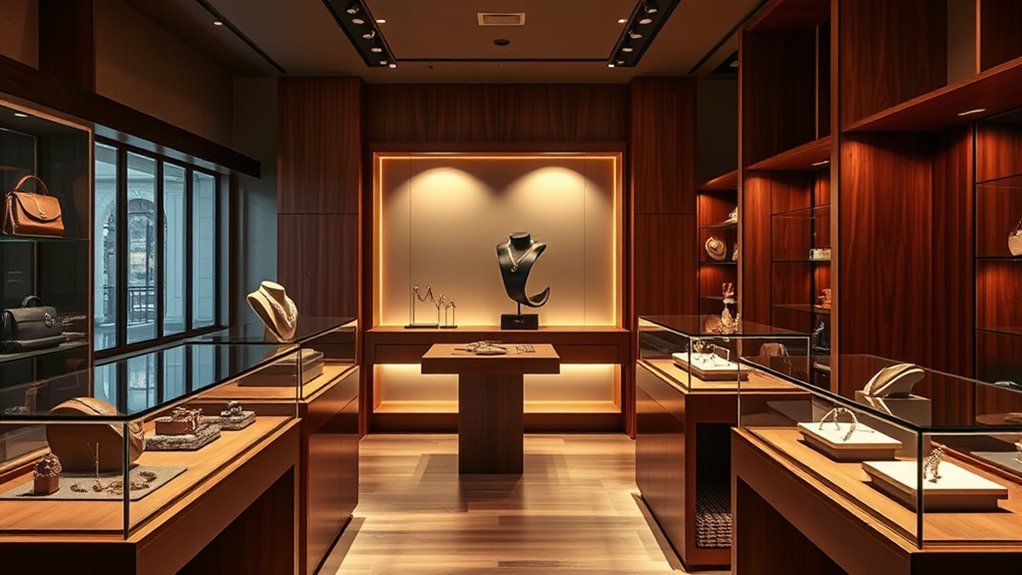
Balancing heritage and innovation is shaping the future of responsible luxury, as brands seek to preserve timeless craftsmanship while embracing sustainable technologies. Heritage brands like Hermès focus on artisanal skills, local sourcing, and upcycling excess materials to promote responsible luxury and uphold ethical practices. Meanwhile, innovative companies such as Gabriela Hearst incorporate scientific methods, bio-plastics, and digital transparency tools, earning awards for their sustainability efforts. Established brands are investing in research and development of eco-friendly materials like Mylo mushroom leather through collaborations with tech companies. This integration of heritage values with cutting-edge sustainable innovations demonstrates the potential for luxury to evolve harmoniously with environmental responsibility. Awareness of seed allergy risks and proper handling of ingredients can further support brands’ commitment to health-conscious and ethically responsible practices. Incorporating sustainable innovations like blockchain for supply chain transparency can help brands demonstrate their commitment to ethical practices and meet consumer demand for authenticity, quality, and sustainability is guiding this balanced approach toward a responsible future. Additionally, understanding the importance of ethical sourcing and transparent supply chains can foster consumer trust and loyalty. Moreover, leveraging data-driven decision-making can optimize supply chain efficiency and reduce environmental impact, aligning business growth with sustainability goals.
Overcoming Challenges and Paradoxes in Ethical Luxury
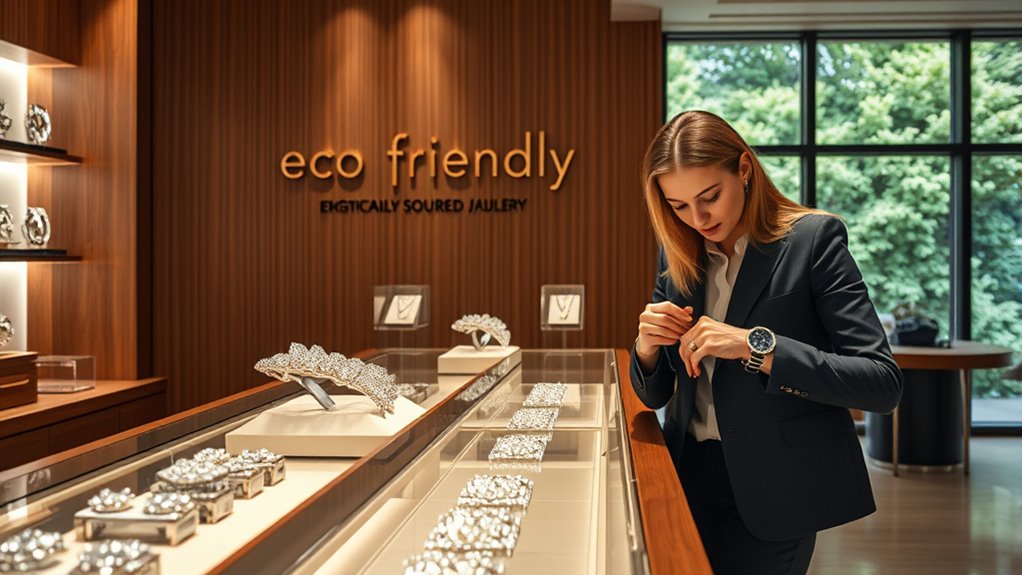
You face the challenge of balancing exclusivity with sustainability, knowing that pushing eco-friendly innovations can sometimes increase resource use. Limited availability of sustainable materials like bio-leathers makes it harder to meet market demands without sacrificing environmental goals. To succeed, you need transparent strategies and redefine luxury as responsible, inclusive, and environmentally conscious. Understanding the store hours and operations of beauty retailers can also help optimize supply chain management and customer engagement during peak shopping times. Incorporating sustainable practices into production processes can further support sustainable practices without compromising quality.
Sustainability vs. Exclusivity Tension
The luxury industry faces a complex challenge: how to uphold exclusivity while adopting sustainable practices. Balancing eco-friendly initiatives with the desire for rarity tests brands’ ability to innovate without sacrificing their prestige. Sustainability often requires resource-intensive processes, making limited editions and high-quality materials more costly and less scalable. Consumers demand sustainable luxury products, yet many still see eco-luxury as less exclusive, complicating marketing efforts. This paradox arises because sustainable materials like bio-leather and upcycled fabrics are expensive and not yet widely available for mass production. To protect their brand reputation, luxury brands must navigate the tension between maintaining their elite status and embracing transparent, ethical practices that meet evolving consumer demand for responsible luxury. Incorporating quality, expertise, and top-tier information can help brands communicate their sustainability efforts more effectively and transparently to modern consumers. Additionally, leveraging digital literacy allows brands to better showcase their ethical initiatives and build trust through authentic storytelling. Developing a sustainable supply chain is essential for long-term success in aligning luxury with environmental responsibility, yet it remains a significant challenge due to current technological and economic limitations. Furthermore, investing in innovative sustainable materials can help bridge the gap between exclusivity and eco-consciousness, fostering a more holistic approach to responsible luxury.
Resource and Material Limits
Luxury brands face significant hurdles in sourcing sustainable materials that meet both ethical standards and high-quality expectations. Limited availability of eco-friendly raw materials like bio-plastics and mushroom leather constrains production, while resource constraints challenge scalability. The supply chain often lacks sufficient recycling and upcycling infrastructure, hindering circular economy efforts. Additionally, some eco-materials, such as bio-based plastics, can have notable environmental impacts, complicating their sustainability credentials. You must navigate these paradoxes to balance resource limits with consumer demand for exclusivity.
| Challenge | Impact |
|---|---|
| Limited sustainable materials | Scarcity hampers scaling production |
| High costs | Limits affordability and accessibility |
| Supply chain complexity | Slows eco-friendly sourcing |
| Circular economy gaps | Restricts recycling efforts |
| Environmental impact | Questions true sustainability |
Consumption Growth Risks
While the demand for sustainable luxury products continues to rise, it can unintentionally drive overall consumption upward, increasing environmental impact. As consumer demand for ethical practices grows, brands face the challenge of balancing profitability with sustainability. The continuous introduction of new designs and trends in luxury fashion requires significant resources, which can amplify environmental pressures despite sustainability efforts. Alternatives to traditional materials like silk, wool, and leather aren’t yet scalable, making it hard for brands to reduce production costs without sacrificing quality or exclusivity. Additionally, eco-friendly products are sometimes seen as less exclusive, encouraging a broader consumer base and higher consumption. This paradox risks undermining environmental benefits, creating a cycle where increased production and consumption threaten the very sustainability goals brands aim to achieve.
Strategies for Integrating Sustainability Into Luxury Branding

To successfully integrate sustainability into luxury branding, brands must adopt innovative strategies that align environmental responsibility with their core identity. Emphasizing sustainable practices, transparency, and social responsibility helps meet consumer demand for eco-luxury. Brands like Kering are reducing greenhouse gases by 40% and establishing circular hubs to promote recycling, showcasing commitment to ethical principles. Using eco-friendly materials such as faux-leather and cruelty-free footwear enhances prestige while aligning with consumer values. Transparency initiatives like digital origin tracking and Environmental Profit & Loss reports build trust and demonstrate accountability. By redefining luxury as synonymous with quality and responsibility, brands foster deeper consumer engagement and loyalty.
| Strategy | Impact |
|---|---|
| Eco-friendly materials | Boosts prestige, aligns with eco-conscious values |
| Transparency efforts | Builds trust, demonstrates accountability |
| Circular hubs | Promotes recycling, reduces waste |
| Ethical sourcing | Reinforces social responsibility, brand loyalty |
Ethical Fashion: Foundations, Benefits, and Industry Shifts
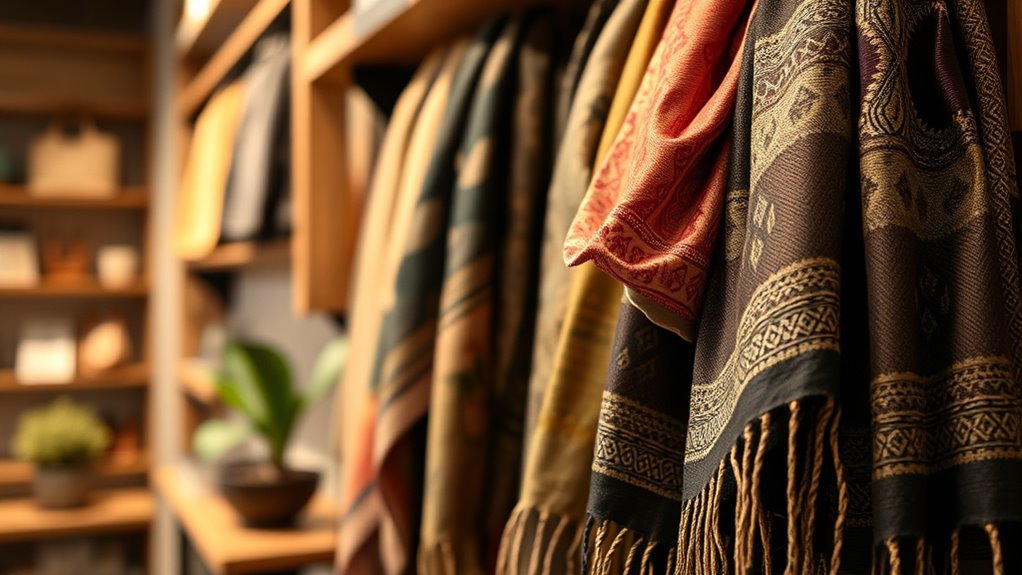
Ethical fashion builds on the growing demand for sustainable and responsible luxury by emphasizing fair labor practices, transparent supply chains, and eco-friendly materials. You, as a consumer, increasingly prioritize social responsibility and environmental impact when choosing brands. This shift encourages industry players to adopt sustainable practices, driven by consumer demand, technological innovations, and regulatory pressures. Benefits include positive social impacts, environmental sustainability, and increased loyalty from conscious shoppers. However, balancing profitability with ethical commitments remains a challenge, especially with higher sourcing costs and the risk of greenwashing. Industry shifts like circular economy models, blockchain transparency, and collaborative consumption are shaping the future of ethical fashion. These changes foster trust and promote responsible luxury, aligning profit with principles.
The Role of Digital Tools and Circular Economy in Ethical Fashion
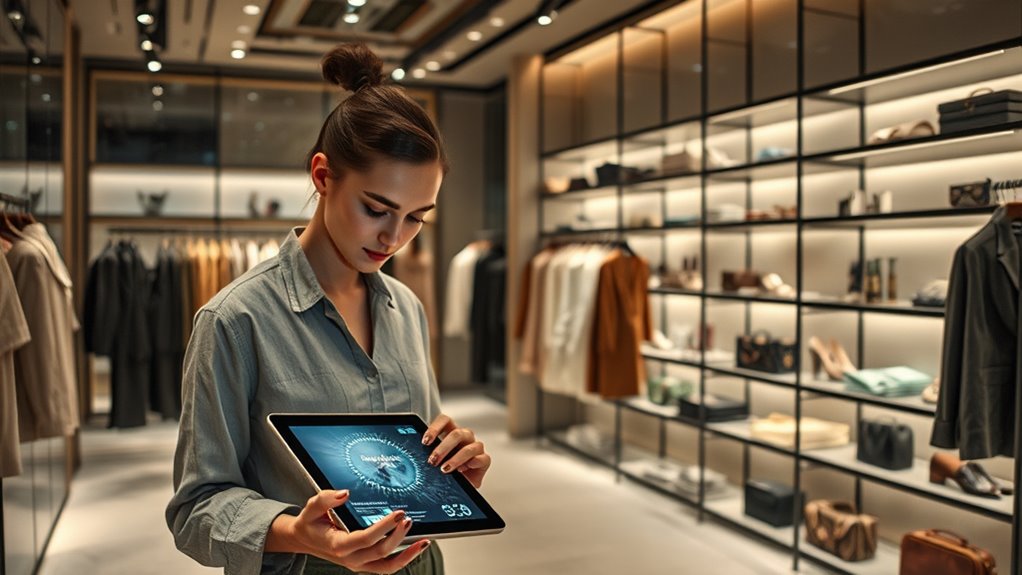
Digital tools are transforming ethical fashion by increasing transparency and enabling responsible practices throughout the supply chain. Digital transparency platforms, like Gucci’s origin tracking, verify ethical sourcing and build consumer trust. Blockchain technology allows real-time traceability of eco-friendly materials, ensuring sustainable practices are upheld from raw material to finished product. Circular economy models, supported by digital platforms, facilitate recycling, resale, and upcycling, reducing waste and extending garment lifespan. Digital marketplaces and rental platforms promote collaborative consumption, encouraging you to rent, resell, or reuse luxury items. Additionally, digital R&D accelerates the development of innovative eco-friendly materials like mushroom leather, fostering sustainable practices. These technological advances help balance profit with principles, making ethical fashion more transparent, accessible, and aligned with circular economy principles.
Frequently Asked Questions
What Is Corporate Social Responsibility Balancing Profit and Ethics?
When you think about corporate social responsibility, you’re balancing making a profit with acting ethically. You actively incorporate social, environmental, and ethical concerns into your business practices. By doing so, you build trust with your customers, improve your brand reputation, and attract responsible investors. You achieve this balance through transparent policies, stakeholder engagement, and long-term commitments, ensuring your company’s growth aligns with positive societal and environmental impacts.
What Is the Most Ethical Luxury Brand?
You’re wondering which luxury brand is the most ethical. While many brands excel in sustainability, Stella McCartney stands out for its animal-free materials and eco-friendly practices. Hermès emphasizes craftsmanship and responsible sourcing, and Gucci leads in transparency and eco-initiatives. Gabriela Hearst innovates with bio-plastics and digital transparency. Ultimately, your choice depends on which values matter most to you—sustainability, transparency, or craftsmanship—making it a personal decision.
Do Luxury Consumers Care About Sustainability?
You might wonder if luxury consumers really care about sustainability. The answer is yes, many do—especially those aged 25 to 40—who prioritize eco-friendliness in their purchases. A survey shows 70% are willing to pay more for sustainable products, but fewer verify brands’ claims. Brands like Gucci and Stella McCartney attract these conscious buyers by being transparent about their sustainability efforts, balancing luxury with environmental responsibility.
What Is Eco-Luxury?
Eco-luxury combines high-end products and experiences with sustainable practices. You’ll find brands using eco-friendly materials like recycled fabrics and bio-plastics, focusing on transparency and ethical sourcing. These brands emphasize durability and timeless design, encouraging you to invest in items that last. As consumer interest grows, they’re innovating with greener materials and methods, making eco-luxury a responsible choice that doesn’t compromise on style or quality.
Conclusion
Balancing luxury with ethics isn’t just ideal—it’s essential. You can lead the way by embracing sustainable practices, like how Stella McCartney pioneers eco-friendly fashion without sacrificing style. Imagine your brand adopting circular economy principles, reducing waste and boosting transparency. By aligning profit with principles, you not only build trust but also shape a responsible future for luxury. Stay committed to innovation and integrity—your customers will thank you for it.



